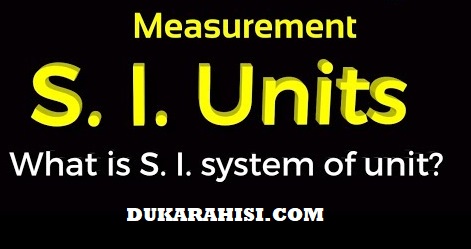SI UNITS OF SOME PHYSICAL QUANTITIES
Units are defined as those tools using which we can measure any physical quantities effectively. For example, if we want to measure length then that can be measured in meters, centimeters, feet etc, again if we have to measure mass then that can be measured in kilograms, grams etc.
So from the above example we can say that there are many units which can be used to measure a particular quantity.
International System of Units ( SI units )
The standardized system of measurement that is most well known and used in the world is the ” International System of Units”. It is NOT abbreviated as “ISOU”. Instead , the ” International System of Units” is abbreviated as ” SI Units” .
The letters SI were taken from the French words that mean International System of Units ( it seems that historically the French were very involved with standardization).
The SI system has “seven base” quantities. These are considered as basic quantities from which other quantities can be mathematically derived. The seven base quantities are:

Advantages of SI System of Unit
- It is a coherent system of unit.
- It is a rational system of unit.
- SI is a metric system.
SI UNITS OF SOME PHYSICAL QUANTITIES USED:
Acceleration, a is metre per second squared (m/s2)
Acceleration due to gravity, g is m/s2 (or N/kg)
Activity (of a radio nuclide) is Becquerel (Bq)
Amount of substance is Mole (mol)
Area (A) is square meter (m2)
Capacitance is Farad (F) [other = C/V]
Density is kilogram per cubic meter (kg/m3) (or g/cm3)
Effort, E and Load, L in machine is Newton (N)
Electric Charge, Quantity of electricity is Coulomb (C)
Electric current, I is Ampere (A)
Electric Resistance is Ohm () [other= V/A]
Electric Potential difference, Emf is Volts (V) [other =W/A]
Energy, Work, Quantity of heat is Joule (J)
Extension , e is meter (m)
Force (Weight)/Tension is Newton (N) [others = kgm/s2]
Frequency , F is Hertz (Hz)
Heat Capacity is Joule per Kelvin (J/K)
Impulse, J is Newton second (Ns)
Length, (L), Displacement and distance is meter (m)
Linear expansivity, ∝ is per Kelvin (K-1 ) [ per Celsius, 0C-1]
Mass is kilogram (kg) [others = grams, tones]
Moment of force (M) is Newton meter (Nm)
Momentum, p is kilogram meter per second (kgm/s)
Power is Watts (W) [others = Horsepower, Hp]
Pressure, stress is Pascal (Pa) [others = N/m2, mmHg, Bar, Atm]
Resistivity, 𝜌 is Ohm meter (m)
Specific latent heat of vaporization/fusion is Joule per kilogram (J/kg)
Specific heat Capacity, C is Joule per kilogram Kelvin (J/kgK)
Speed, Velocity is meter per second (m/s) [other = km/h]
Spring constant, k (Force constant) is Newton per meter (N/m)
Temperature is Kelvin (K) [others = Celsius, 0C/ Fahrenheit, 0F]
Time is second (s) [others = minutes, hours]
Volume is cubic meter (m3) [others = cm3,mm3]
Wave length, is Meter (m)
UNITS CONVERSION
1 kilo unit = 1000 (103) Units
1 Mega units = 1,000,0000 (106) units
1 Giga unit = 1,000,000,000 (109) units
1Unit = 0.001 (10-3) mill unit
1 Unit = 0.000001(10-6) micro unit
1 unit = 0.000000001 (10-9) nano unit
10m/s = 36km/h
1 m3 = 1000 Litres
1 Litre = 1000 cm3
1g/cm3 = 1000kg/m3
1 atm = 760 mmHg = 1.01325 x 105 Pa (N/m2)
1 Hp = 746W
1AU = 1.4960 x 1011m → AU = Astronomical unit
Symbols:
Mega = M, Kilo = k, Giga = G, mill = m, micro =𝝁, nano = n
Examples:
Change the following
3MHz into Hz → 1MHz = 106Hz, 3MHz =Hz?, = 3×106Hz
(b) 5k into → 1k = 103, 5k =? , 5k = 5000
50mA into A → 5 x 10-2A or 0.05A
8 𝜇F into F → 8 x 10-6 F
50 kg into g → 50,000g
25m/s into km/h → 90k/h



























































